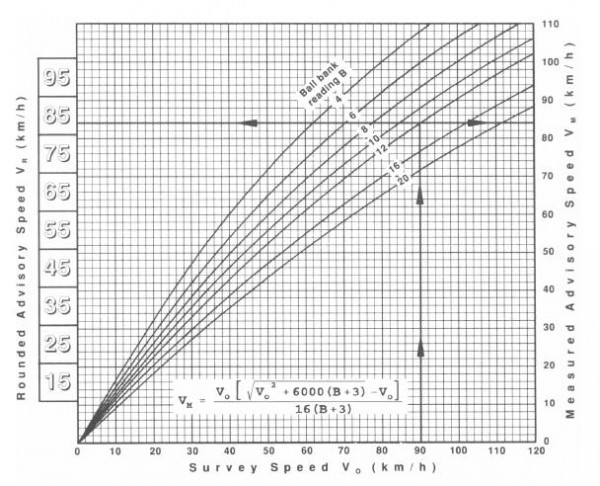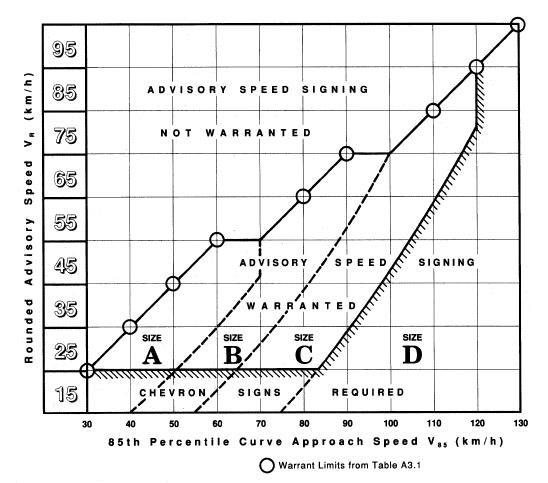Information on the treatment of curves is provided in treatment of curves. Curve warning signs, W12-1 and W12-2 series, combined with W12-3.2 curve sign supplementary advisory-speed signs should be installed on the approaches to horizontal curves when warranted by an Advisory Speed Assessment Survey.
|
VM |
Measured advisory speed |
|
VO |
Constant known speed of test vehicle around the curve |
|
VR |
Rounded advisory speed |
|
V85 |
85th percentile curve approach speed |
|
VS |
Curve advisory speed |
The measured advisory speed VM is assessed by driving a test vehicle equipped with a ball bank gauge and a calibrated speedometer (or proven and accepted digital alternative) around the curve at a constant known speed VO and observing the highest reading B, of the gauge. VM is then obtained graphically from Appendix Figure 1 or by calculation, using the survey values. The rounded advisory speed VR is also derived from Appendix Figure 1. Each of nine permitted values of VR, i.e. 15, 25, 35, 45, 55, 65, 75, 85 and 95km/h, is matched to a specific 10km/h range of VM, e.g. VR = 15km/h covers the range of VM from 11 to 21km/h. The nine values of VR are listed in Appendix Table 1 and shown on Appendix Figure 1; no other values of VR should be used.
At least two survey runs should be made in each direction for each curve because advisory speed values can differ by direction. Two runs in the same direction for each curve should produce the same result before that value can be adopted. If the two runs produce differing results a third run should be made to determine which of the previous results is appropriate.
Only those curves that meet the warrant given in Appendix Table 1, also illustrated in Appendix Figure 2 should be signed for advisory speed. The criteria for this warrant are the rounded advisory speed VR and the 85th percentile curve approach speed V85. The 85th percentile curve approach speed V85 is an estimate of the speed that only 15% of vehicles would exceed and it is assessed just before the point where vehicles start to slow for the curve.
As a guide:
Appendix Table 1 shows the warrant values required for the installation of advisory speed signs. These values are also illustrated in Appendix Figure 1 and Appendix Figure 2.
Appendix Table 1: Advisory speed sign warrant values
| Rounded advisory speed VR (km/h) | Signing warranted when V85 meets or exceeds these values (km/h) |
|---|---|
|
15 |
30 |
|
25 |
40 |
|
35 |
50 |
|
45 |
60 |
|
55 |
70 |
|
65 |
80 |
|
75 |
90 |
|
85 |
110 |
|
95 |
130 |
When the warrant for signing a curve is met, VR becomes the curve advisory speed VS, adopted for signposting. Removal of existing advisory speed signs may be considered if VR does not meet the warrant and, in the opinion of the RCA, the sign has ceased to be of value.
Where advisory speed signing is not warranted, curve warning signs alone may be installed in situations where the curve is deceptive and not obvious to approaching drivers. Advisory speed signs should not be installed when VM is greater than 101km/h, ie VR would be 105km/h.
Appendix Figure 1: Determination of advisory speed on speed on horizontal curves

View larger image [JPG, 74 KB]
Example in Appendix Figure 1: Observed survey speed, VO, is 90km/h and ball bank reading, B, is 12. From the graph, or by calculation, VM is approximately 84km/h. From the graph VR is 85km/h and this is the value of the curve advisory speed, VS, to be sign posted if the warrant given in Appendix Table 1 is met.
The size of curve warning and advisory speed signs should be increased as the degree of hazard increases. To determine the minimum size of a sign for a particular application refer to TCD manual Part 1, and Appendix Figure 2 and Appendix Table 2 of this manual.
Appendix Figure 2: Curve warning and advisory speed signs on horizontal curves - signing warrant and size determination

View larger image [JPG, 49 KB]
Appendix Table 2: Minimum sign size
| Sign type | Minimum sign size | |||
|---|---|---|---|---|
| A | B | C | D | |
| Curve advisory | 600 x 600 | 750 x 750 | 900 x 900 | 1200 x 1200 |
| Advisory speed | 600 x 400 | 750 x 750 | 900 x 600 | 1200 x 800 |
A curve warning sign should be located where approaching drivers have an uninterrupted view of it over a distance of at least 120m in rural areas and at least 60m in urban areas and be in advance of the curve by at least the distance specified in Appendix Table 3.
Appendix Table 3: Location of curve warning and advisory speed signs
| Speed difference between V85 and VS (km/h) | Minimum distance of sign in advance of curve tangent point (m) |
|---|---|
|
20 |
100 |
|
30 |
120 |
|
40 |
130 |
|
50 |
140 |
|
60 |
150 |
|
70 |
160 |
|
80 |
170 |
Isolated curves and adjacent curves should be signed as appropriate with one of the signs listed in Table 3‑1.
W20-1 chevron sight board - horizontal curve signs should only be installed on horizontal curves where the curve advisory speed is 15km/h or more below the 85th percentile operating speed, or where the hazard is such as to warrant Size D signs, as shown on Appendix Figure 2. The curve advisory speed shown on the curve warning sign must also be shown on the W20-1 signs.
W20-2 chevron curve indicator signs are normally used in conjunction with a W20-1 sign to further delineate the curve.
W20-2 signs may also be used on horizontal curves where the installation of a W20-1 sign is not warranted but, in the opinion of the RCA, some additional delineation is required throughout the curve, eg a long, large deflection angle, horizontal curve.